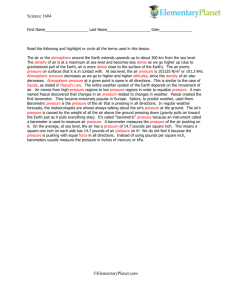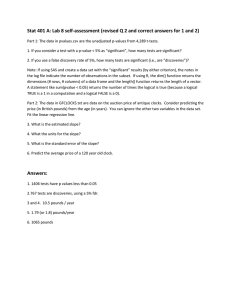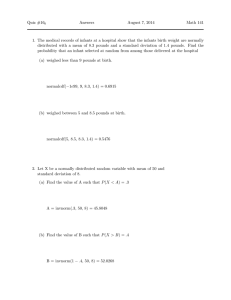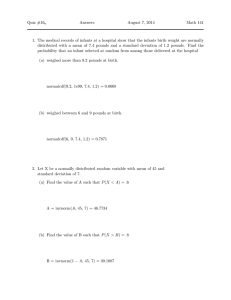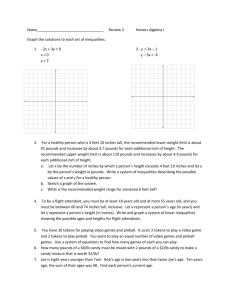CERTAIN PROPERTIES Of PAPREG AFFECTED EY WIT-PRESS PRESSURE ON MITSCI1EPLIal L?AS[ PAPER
advertisement
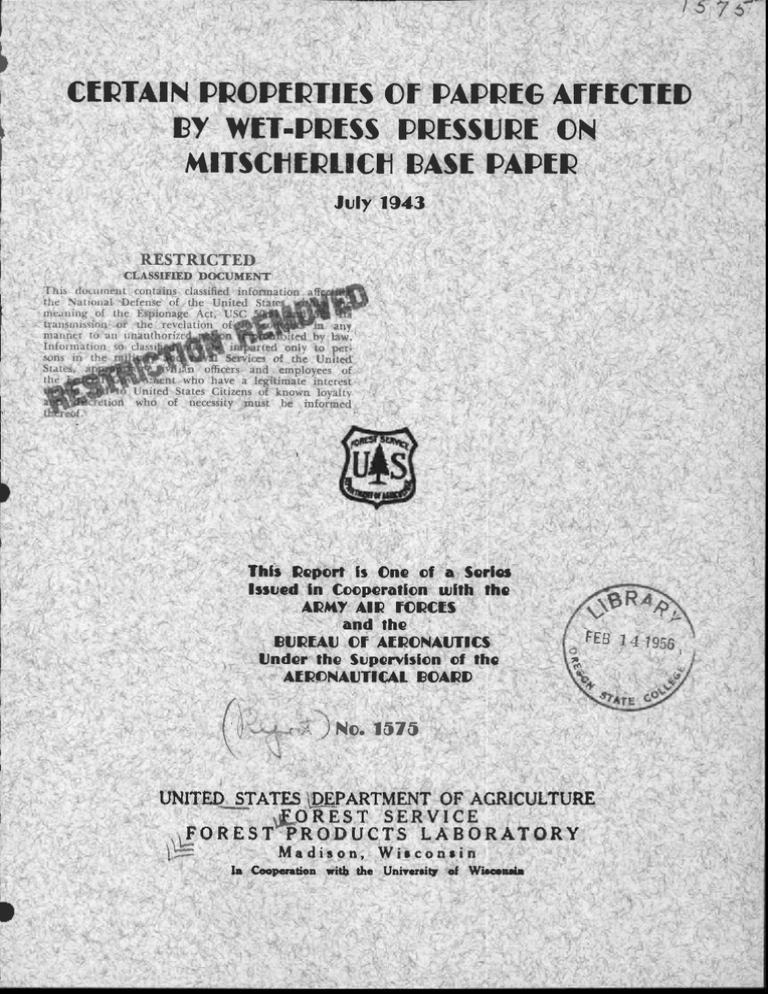
CERTAIN PROPERTIES Of PAPREG AFFECTED EY WIT-PRESS PRESSURE ON MITSCI1EPLIal L?AS[ PAPER July 1943 RESTRICTED CLASSIFIED DOCUMENT This document : contains classified information aff the National- Defense of the United Star meaning of the Espionage Act, USG transmission or the - revelation of any mariner to an unauthorize cited.. by law. Information so dassi•atter" only to persons in the Services of the United States, a officers and employees of the ment-who have a legitimate interest United States Citizens of known loyalty retiOn who of necessity Must be , informed pe6f. This Report is One of a Series Issued in Cooperation with the ARMY All? FORCES and the 'BUREAU OF AERONAUTICS Under the Supervision of the AERONAUTICAL MARV ) No. 1575 UNITED STATES APARTMENT OF AGRICULTURE OREST SERVICE FOREST PRODUCTS LABORATORY Madison, Wisconsin la Cooperation with the University of Wisconsin CERTAIN PROPERTIES OF PAPREG AFFECTED BY WET-PRESS PRESSURE ON MITSCHERLICH BASE PAPER By G. E. MACKIN, Associate Industrial Specialist R. J. SEIDL, Assistant Chemical : ', ntineer P. K. BAIRD, Senior Chemist Introduction , Preliminary tests previously reported by the Forest Products LaboratoryL indicated that some properties of papreg were influenced by the amount of wet-press pressure applied to base paper during its fabrication on the paper machine. This report presents more conclusive data on the effects of using Mitscherlich type sulfite papers produced under five wet-press pressures on certain properties of the laminated plastic. Variations in wet-press pressure affect the density, porosity, thickness, and other properties of paper, and these in turn individually affect the properties of papreg. The results reported here are based on a direct correlation between wet-press pressure and the properties of papreg. Experimental Material Paper making.--The preparation of papreg for this investigation included the production of papers processed under various wet-press pressures followed by a uniform impregnating and laminating procedure. A commercial Mitscherlich sulfite pulp, meeting the requirements for this purpose, was used for the experiments. All runs were made from the same lot of pulp and all paper machine variables, except the wet-press pressure, were held as constant as possible throughout the series. The pressure used in each run was applied to all of the three wet presses. The pressure per lineal inch applied to the wet web of the paper was approximately 6.5 times that indicated on the gage. The gage pressure indicating the pneumatic force applied to the lever system of the presses was used for convenience in reporting the operating conditions. 1 -This mimeograph is one of a series of progress reports prepared by the Forest Products Laboratory to further the Nation's war effort. Results here reported are preliminary and may be revised as additional data become available. ?Restricted Mimeograph No. Aircraft." Mimeo. No. 1575 1395, "High-strength Laminated Paper Plastics for -1= The pressures applied for each of the runs and the physical properties of the papers produced are given in table 1. If stock is delivered to the wire at a constant rate, the thickness, porosity, density,and strength of the paper can be altered by the pressure applied at the wet presses. Increasing the wet-press pressure over the range used in this series caused a marked increase in tensile strength, porosity value, and density and a decrease in thickness. The combined effect of these changes, as measured by the wetpress pressure, was reflected in the final properties obtained in the papreg. Impregnating, laminating testing.--Bakelite resin No. Bv.-16303 36.5 was used to impregnate these papers. The resin content was held at percent + 0.5 percent and the volatile content at 4.5 percent + 0.1 percent throughout the series. Plastic test panels were made by parallel laminating the various impregnated papers at both 75 pounds per square inch and 250 pounds per square inch for 12 minutes at 325° F. Test specimens were prepared conditioned, and tested in tension, compression, and bending, and for specific gravity, and water absorption, according to the "Proposed Federal Specification for Organic Plastics, General Specification (Methods of Physical Tests), July 1942." Discussion of Results Specific gravity.--The specific gravity of papreg molded at 75•pounds per square inch increased from 1.19 to about 1.36 as the wet-press pressure applied to the paper was increased through the range of 2.5 to 25.0 pounds gage pressure. At 250 pounds per square inch molding pressure, the specific gravity of the papreg increased from 1.37 to about 1,41 under the same wetpress pressure conditions (table 2 and fig. 1) and appeared to be approaching a maximum constant value. Edgewise compressive strength.--The maximum edgewise compressive strength of papreg molded at 75 pounds per square inch increased from about 16,000 to about 20,700 pounds per square inch as the wet-press pressure was increased (fig. 2). Papreg molded at 250 pounds per square inch increased in compressive strength over the same range of wet-press pressures, but the degree of improverment was not appreciable. This effect can be explained by the fact that the specific gravity of papreg made from paper processed under high wet-press presrsure and molded at 75 pounds per square inch (fig. 1) approached that usually obtained with paper subjected to ordinary low wet-press pressure (2 to 5 pounds gage pressure) and molded at the higher pressure of 250 pounds per square inch. Modulus of rupture.--The modulus of rupture of papreg molded at 75 pounds per square inch increased from about 27,600 to about 37,200 pounds per square inch as the wet-press pressure was increased over the range used. At 250 pounds per square inch laminating pressure, the modulus of rupture increased from about 36,000 to about 39,500 pounds per square inch (fig. 3). These results show that by using paper made under high wet-press pressure papreg can be molded at 75 pounds per square inch having a bending strength equal to that obtained at 250 pounds per square inch molding pressure using ordinary paper. Mimeo. No. 1575 -2- Ultimate tensile strength.--The ultimate tensile strength of papreg molded at 75 pounds per square'inch increased from about 32,600 to about 41,000 pounds per square inch as the wet-press pressure was increased. As in the case of compression and bending, the increase in the tensile strength of papreg molded at 250 pounds per square inch was not as large (fig. 4). Moduli of elasticity.--The moduli of elasticity in compression, bending, and tension, of papreg molded at 75 pounds per square inch and 250 pounds per square inch increased with an increase in wet-press pressure. The modulus of. elasticity in compression (fig. 5) increased from about 2,760,000 to about 3,035,000 pounds per square inch in papreg molded at 75 pounds per square inch through the range of wet-press pressures used. In bending, the increase was from about 2,400,000 to about 2,900,000 through the same range of wetpress pressure. In tension, this value increased from about 2,860,000 to 3,200,000 in papreg molded at 75 pounds per square inch. Papreg molded at 250 pounds per square inch showed slight but definite increases in moduli of elasticity over the range of wet-press pressures used. Water absorption.-- The water absorption of papreg molded at 75 pounds per square inch decreased from 7.3 percent to about 4.5 percent as the wetpress pressure was increased in the range of papers used, but papreg molded at 250 pounds per square inch did not change appreciably in water absorption (fig. 6). Conclusions Under the conditions described in this report certain mechanical and physical properties of papreg were definitely affected by changes in such sheet properties as density, thickness, porosity, and strength, all of which were varied by changes in the wet-press pressure used in making the laminating paper. The following effects on the papreg were observed when the wet-press pressure used on the paper machine :Bras raised from 2.5 to 25.0 pounds gage pressure: When papreg was molded at 75 pounds per square inch, specific gravity was increased 14 percent, edgewise compressive strength was raised 30 percent, the ultimate tensile strength was raised 26 percent, modulus of rupture was raised 35 percent, the average of the three moduli of elasticity was raised 13 percent, and the total water absorption was lowered 36 percent. When papreg was molded at 250 pounds per square inch, the specific gravity was raised 3 percent, the edgewise compressive strength was raised 8 percent, the modulus of rupture was raised 10 percent, the ultimate tensile strength was raised 9 percent, the average of the three moduli of elasticity was raised 5 percent, and the total water absorption was not affected. The effects of variations in wet-press pressure in paper making are evidently much more pronounced in papreg molded at 75 pounds per square inch than in that molded at 250 pounds per square inch. The advantage of using higher wet-press pressures appears to be chiefly the ability to obtain higher strengths at the lower laminating pressures. Mimeo. No. 1575 -3- Table 1. --Properties of five papers produced under variations in wet-press pressure Physical properties S Machine : Viet-press : Ream : Thickness : Porosity : Density : Average run : : tensile gage : weight : number : strength pressure : 25 x : : 40/500 : Pounds : Pounds : ......._. : : Mils : Sec. per : Gm. per : Lb. per : sq. in, : 100 cc : co 2070 . 2.5 : 30. g : 2.g8 : 3 : 0.59 • 5;95o 2071 : 7.o : 30.9 : 2.66 : 4 1 .64 : 7,280 2072 : 12.0 : 30.5 : 2.50 : 8 .67 : 8;645 : ; 2073 % 18.0 : 30.8 t 2.42 : 12 1 .70 : 9,3-J-0 2074 : 25.0 : 29.5 : 2.28- : 13 : .71 : 10„)030 Mimeo. No. 1575 Table 2.--Effects of wet-press pressure applied to paper as reflected in papreg properties Properties of papreg1..... : Papreg : Wet- : :Specific:Water Static number : press : : Compression : Tension :gravity : abbending edgewise : gage : : :sorp : :pressure: . 1 tion : :Ultimate:Modulus:Maximum:Modulus:Modulus:Modulus: : 24 of :ofelas-: :ofelas-: :ofelas-: : :hours :ticity :rupture:ticity : : :ticity : : : : : : : Per: cent Lb. : Lb. per:• 1,000 : Lb.per: 1,000 : Lb.per:• 1,000 : : sq. in.: lb.per: sq.in.: lb.per: sq.in.: lb.per: : sa.in.: : sq.in.: : sq.in.: : -......--_ : : Parallel Laminated at 75 Pounds per Square Inch : : . 32, 6 67 : 2,85 6 : 1 5, 930: 2 ,76 1 : 27,640: 2 ,460 •. : 1.1 9 7.3 7.0 : 36,410 : 3,034 :• 17,760: 2,810 : 31,880: 2,581 : 1.26 5.6 2072-1A: 12.0 39,210 : 3,096 : 19,340: 3,008 : 34,220: 2,732: 1.34 ; 4.4 2070-1A:2.5 2071-1A: : :. • 2073-1A: 18.0 : 39,217 : 3,155 : 20,760: 2,978 • 35,800: 2,784 : 1.37 : 4.1 2074-1A: 25.0 : 41,187 : 3,214 : 20,680: 3,037 • 37,190:• 2,886: 1.36 : 4.7 Parallel Laminated at 250 Pounds per Square Inc • 2070-1 2.5 : 40,400 : 3,220 : 20,780: 3,046 : 35,880: 2,936 : 1.37 : 4.2 2071-1 : 7.0 : • : 2072-1 : 12.0 : : • : • : • 41,950 : 3,408 : 22,810: 3,172 : 37,200:-3,030: 1.40 4 4.2 • : . : . 40,680 : 3,260 : 21,930: 3,092 • 39,000: 2,984. 1.41 : 4.0 2073-1 : 18.0 : 43,403 : 3,306 : 22,160: 3,110 : 38,240; 2,934: 1.40 : 4.1 2074-1 : 25.0 : 43,933 • 3,466 : 22,520: 3,139 : 39,550a 3,088. 1.41 : 4.2 Laminates cured for 12 minutes at 325° F. Strength tests made parallel to fiber direction (grain). All tests made according to "Proposed Federal Specification. for Organic Plastics; General Specification (Methods of Physical Tests), July 7, 1942." Mimeo. No. 1575

